Thursday, 14 June 2012: Rouen to Le Havre, via Jumiège
Written 18 June 2012
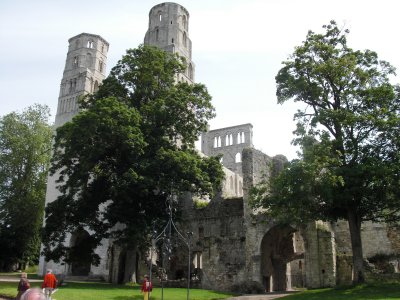
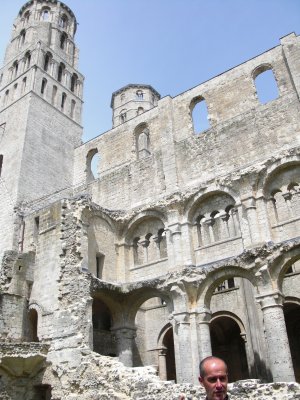 Thursday morning, mirabile dictu, a little sun was shining—pretty much our first since leaving Tallahassee!—and it was time to pick up our rental car. The plan was to take a taxi from our hotel, down by the river, a block from the road out of town, back uptown to the Europcar office in train station, then bushwhack back through the one-way streets to head west to Le Havre. Looking out our hotel-room window, though, what did I see, but a Europcar office, one block away and actually on the road out of town! I thought about it the whole time we spent in Rouen, and Thursday morning, while the others finished packing, I took our car-rental paperwork over to that office and askrd if we could pick up a car there rather than going back to the station. Sure, said the lady, but all I have available is a Danya Logan. Will it hold three people and luggage? Oh, yes, she said, I don't have a diagram of that model, but it's a "break." Okay, I think that means "station wagon." We accordingly trundled our bags down the block to the office, signed off on everything, waited around a little, and were issued, sure enough, a five-passenger car with a much bigger "wayback" than we usually get (and all for the same price!). While David went back to the office to discuss why the missing spare tire (which the garage guy assured us was no longer needed because the car had been refitted with puncture-proof tires) was listed under "preexisting damage," CJ and I figured out how to fit everything under the cover in the back (no suitcase in the back seat this time!). In a total space of maybe 20 yards, we turned left out of the garage, left again, and right onto the main road toward Le Havre and were off and running.
Thursday morning, mirabile dictu, a little sun was shining—pretty much our first since leaving Tallahassee!—and it was time to pick up our rental car. The plan was to take a taxi from our hotel, down by the river, a block from the road out of town, back uptown to the Europcar office in train station, then bushwhack back through the one-way streets to head west to Le Havre. Looking out our hotel-room window, though, what did I see, but a Europcar office, one block away and actually on the road out of town! I thought about it the whole time we spent in Rouen, and Thursday morning, while the others finished packing, I took our car-rental paperwork over to that office and askrd if we could pick up a car there rather than going back to the station. Sure, said the lady, but all I have available is a Danya Logan. Will it hold three people and luggage? Oh, yes, she said, I don't have a diagram of that model, but it's a "break." Okay, I think that means "station wagon." We accordingly trundled our bags down the block to the office, signed off on everything, waited around a little, and were issued, sure enough, a five-passenger car with a much bigger "wayback" than we usually get (and all for the same price!). While David went back to the office to discuss why the missing spare tire (which the garage guy assured us was no longer needed because the car had been refitted with puncture-proof tires) was listed under "preexisting damage," CJ and I figured out how to fit everything under the cover in the back (no suitcase in the back seat this time!). In a total space of maybe 20 yards, we turned left out of the garage, left again, and right onto the main road toward Le Havre and were off and running.
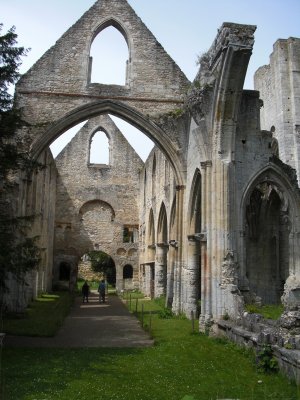
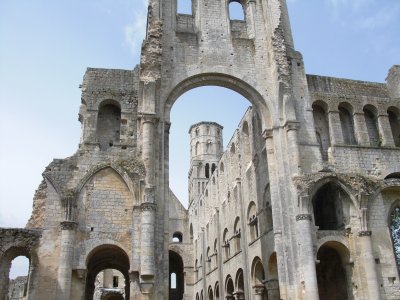 West of Rouen, the Seine takes a series of deep meanders, forming a series of "peninsulas" bounded on three sides bythe river. We turned off the direct road to follow a much smaller one along the banks of the Seine (and, we were assured by signposts along the way, the Route des Fruits—yes, the road was lined with orchards) down one of the meanders and partway up the other side to the site where, in about 645 A.D., Saint Philibert founded the abbey of Jumiège, to take in the sick and indigent and house travellers. The abbey prospered and grew, became rather rich, and started building a beautiful romanesque church.
West of Rouen, the Seine takes a series of deep meanders, forming a series of "peninsulas" bounded on three sides bythe river. We turned off the direct road to follow a much smaller one along the banks of the Seine (and, we were assured by signposts along the way, the Route des Fruits—yes, the road was lined with orchards) down one of the meanders and partway up the other side to the site where, in about 645 A.D., Saint Philibert founded the abbey of Jumiège, to take in the sick and indigent and house travellers. The abbey prospered and grew, became rather rich, and started building a beautiful romanesque church.
In the 9th century, the building program was seriously interfered with by a long series of Viking raids. The Vikings sailed up the Seine every few years, sometimes as far as Paris, pillaging all the way. Rich abbeys like Jumiège were prime targets and got looted repeatedly. After 150 years or so of that, the monks gave up and moved out, declaring the site hopeless.
The Viking (= Norseman = Norman) chieftain who's depredations led directly to that decision was Rollo (Rollon in French), who was so successful in the valley of the Seine that he settled there, in Rouen, and founded the dukedom of Normandy, of which he was first duke. He converted to Christianity (as did most of his crew) and married a local.
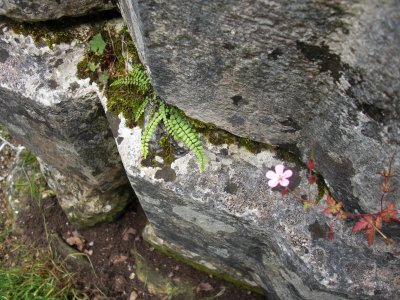
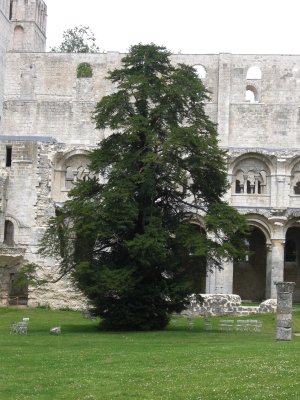 Their son William, raised a Christian, invited the monks back to Jumiège—Normans wouldn't be pillaging Christian establishments any more. The monks came, their activities and the building campaign resumed, and all was well for a good long time. Four or five generations later, in 1066, a descendent of William's (another William) invaded and conquered England.
Their son William, raised a Christian, invited the monks back to Jumiège—Normans wouldn't be pillaging Christian establishments any more. The monks came, their activities and the building campaign resumed, and all was well for a good long time. Four or five generations later, in 1066, a descendent of William's (another William) invaded and conquered England.
Anyway, Jumiège, though never quite as rich as it had been, did just fine. The romanesque church was completed and was much taller and narrower than buildings in that style usually were. Before the advent of buttresses, and then flying buttresses, the only way to build higher was to thicken the walls, and a point of diminishing returns was sooned reached. At Jumiège, though, the roof was wooden rather than stone vaults and was therefore much lighter, so taller walls were possible. The abbey remainedin commission until (yes, you guessed it) the revolution, when it was nationalized and sold as (yes, you guessed it) a stone quarry. The owner planned to bring down the towers with explosives but never got around to the task. It's now a magnificent ruin.
We arrived just in time for a French-language tour, which pointed explained the original layout of the site and showed us where the three missing sides of the cloister would have been and where all the "practical" parts of the organization (stables, bakery, dairy, scriptorium, vegetable gardens, kitchen, latrines, dormatories, guesthouse, etc.) would have been. He was a really fast talker, but we managed to keep up. CJ was a good sport about understanding so little, but I was able to translate the high points for her.
The photo of the little spleenwort and the cranesbill flower is just decorative, but the yew to their right is 500 years old—the oldest tree on the site that was originally planted by the monks. The head popping up into one of the photos above that is our guide.
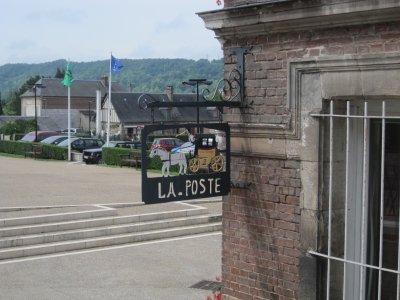
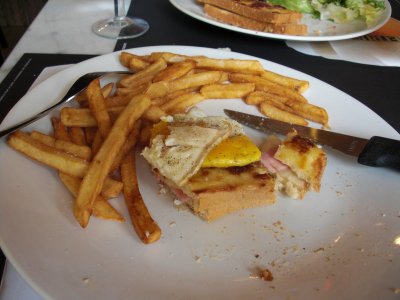 After the tour, we adjourned to the to a bar-brasserie near the post office (here's it's lovely old-fashioned sign; the building was still labeled "PTT," for post, telephone, and telegraph, dating from the time when all three functions, plus savings bank, were with the purview of the postal service).
After the tour, we adjourned to the to a bar-brasserie near the post office (here's it's lovely old-fashioned sign; the building was still labeled "PTT," for post, telephone, and telegraph, dating from the time when all three functions, plus savings bank, were with the purview of the postal service).
We all had croque messieurs, the plural of croque monsieur (actually mine, the last of which is shown here, was a croque madame, because it came with an egg) and got into a lively discussion with the proprietress and another client about education, flight from the countryside to the cities, educational inequality, French and American politics, and much else. Again, CJ was a very good sport.
Written 20 June 2012
By the time we got to Le Havre, the rain had returned. I had carefully printed Google maps showing the location of our hotel, but as usual, we had trouble with the transition from the large map of all of Normandy (which tends just to show towns as blotches) to the smaller area map (from which Google omits all route numbers, many street names, and any scale of distance. Fortunately, the Accor people signpost their establishments well, so we picked up a big sign sign at the edge of town saying, "Mercure, second right; Ibis, "turn right at the fifth stoplight"; etc., and the folks at reception directed us around the block to their underground parking garage.
CJ and I went out for a walk in the drizzle, mostly to scope the place out but secondarily to check the state of the Boulevard Strasbourg—signs at the edge of town had said that it was under construction. That turned out to be an understatement—it was a morass of excavation from end to end. Every third or fourth side street was able to cross it at right angles, but driving along it was out of the question and therefore so was following the Google driving directions to our dinner restaurant. So CJ and I walked as far as the town hall (where that street ended) checking out parallel streets (yes, Le Havre has some parallel streets! It was bombed flat during WWII, then reconstructed in more rectilinear fashion) and found a route that we thought would get us past the construction zone and another that would get us back, despite all the usual one-ways. (The first one worked; the second one would have, too, if I hadn't missed a turn, but we were able to compensate. That part of the city is interrupted by several rectangular boat basins, which provide landmarks when you can't spot street signs and which constrain the choices of streets to take.) Strangely, though, on our walk, aside from a chain filling station named "Le Mutant," we didn't see much that was architecturally interesting or even any interesting window shopping.
Our dinner was at La Petite Auberge, only a 1/5 in last year's GM guide and missing entirely from this year's (we just today (21 June) acquired a copy of the 2012 guide and can now compare scores), but we think the place is underrated. From the menu at 40 euros, we all chose the same starter and same dessert, but different main courses.
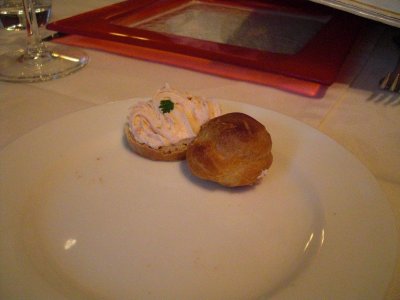
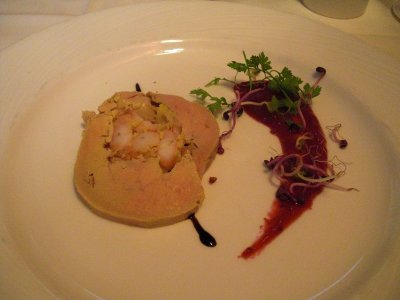 The amuse-bouche consisted of (for each of us) a small cream puff filled with foie gras and a little round toast topped by some sort of tasty seafood fluff. CJ and I told David is was salmon, and he pronounced it delicious, but I suspect it was tarama (herring roe) instead.
The amuse-bouche consisted of (for each of us) a small cream puff filled with foie gras and a little round toast topped by some sort of tasty seafood fluff. CJ and I told David is was salmon, and he pronounced it delicious, but I suspect it was tarama (herring roe) instead.
First course, all: A terrine of foie gras and langoustine tails with a comet of beet purée made with "old Irish whisky" and a streak of balsamic syrup, garnished with radish sprouts and chervil. You can see the cross sections of three langoustine tails in the center. It came with brioche toast.
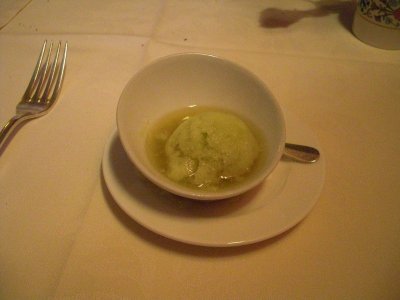
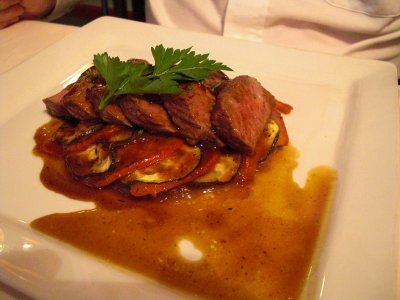 Entremet (palate cleanser), all: A ball of apple sorbet in a bowl of Calvados. When I called it a "trou Normand," the waiter assured us that a real, authentic trou Normand was just a glass of Calvados and that the sorbet was a popular but newfangled 20th-century innovation.
Entremet (palate cleanser), all: A ball of apple sorbet in a bowl of Calvados. When I called it a "trou Normand," the waiter assured us that a real, authentic trou Normand was just a glass of Calvados and that the sorbet was a popular but newfangled 20th-century innovation.
Main course, David: Medallions of lamb with rosemary and sweet peppers and a "Bayaldi" (whatever that is) of vegetables.
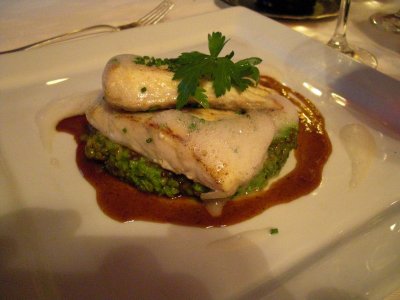
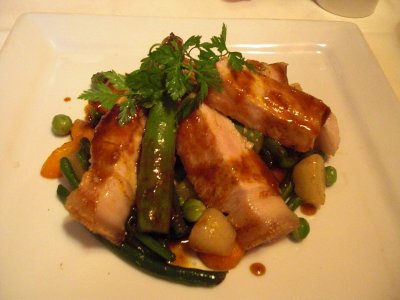 Main course, CJ: Turbot on a bed of delicious creamy "risotto" of green quinoa surrounded by meat juices and a foamy emulsion of lemon grass. Yum.
Main course, CJ: Turbot on a bed of delicious creamy "risotto" of green quinoa surrounded by meat juices and a foamy emulsion of lemon grass. Yum.
Main course, me: "Carré" of pork (a cut somewhat streaked with fat, like bacon, but much leaner), grilled, then sliced and served on a bed of the "vegetables of the moment" (peas, tiny green beans, baby turnips, broad beans, and one fat spear of asparagus), all glazed with truffle-flavored meat juice. Delicious!
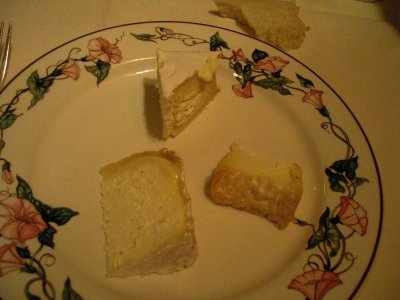
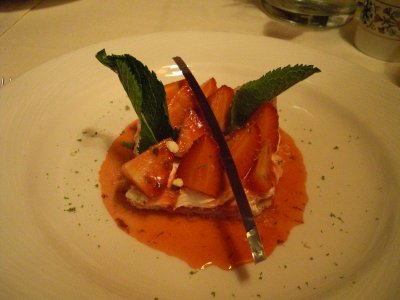 The cheeses rang the usual changes and were excellent. I think this is my plate. David, of course went for a blue and CJ for a couple of local Norman specialties.
The cheeses rang the usual changes and were excellent. I think this is my plate. David, of course went for a blue and CJ for a couple of local Norman specialties.
For dessert, we all chose the Gariguette strawberries on a thin, crisp pastry layer spread with lime cream. The black strip is chocolate. Excellent.
This entire meal, exclusive of wine, was 40 euros a head, less than at Chez l'Ami Jean!
previous entry
List of Entries
next entry

 Thursday morning, mirabile dictu, a little sun was shining—pretty much our first since leaving Tallahassee!—and it was time to pick up our rental car. The plan was to take a taxi from our hotel, down by the river, a block from the road out of town, back uptown to the Europcar office in train station, then bushwhack back through the one-way streets to head west to Le Havre. Looking out our hotel-room window, though, what did I see, but a Europcar office, one block away and actually on the road out of town! I thought about it the whole time we spent in Rouen, and Thursday morning, while the others finished packing, I took our car-rental paperwork over to that office and askrd if we could pick up a car there rather than going back to the station. Sure, said the lady, but all I have available is a Danya Logan. Will it hold three people and luggage? Oh, yes, she said, I don't have a diagram of that model, but it's a "break." Okay, I think that means "station wagon." We accordingly trundled our bags down the block to the office, signed off on everything, waited around a little, and were issued, sure enough, a five-passenger car with a much bigger "wayback" than we usually get (and all for the same price!). While David went back to the office to discuss why the missing spare tire (which the garage guy assured us was no longer needed because the car had been refitted with puncture-proof tires) was listed under "preexisting damage," CJ and I figured out how to fit everything under the cover in the back (no suitcase in the back seat this time!). In a total space of maybe 20 yards, we turned left out of the garage, left again, and right onto the main road toward Le Havre and were off and running.
Thursday morning, mirabile dictu, a little sun was shining—pretty much our first since leaving Tallahassee!—and it was time to pick up our rental car. The plan was to take a taxi from our hotel, down by the river, a block from the road out of town, back uptown to the Europcar office in train station, then bushwhack back through the one-way streets to head west to Le Havre. Looking out our hotel-room window, though, what did I see, but a Europcar office, one block away and actually on the road out of town! I thought about it the whole time we spent in Rouen, and Thursday morning, while the others finished packing, I took our car-rental paperwork over to that office and askrd if we could pick up a car there rather than going back to the station. Sure, said the lady, but all I have available is a Danya Logan. Will it hold three people and luggage? Oh, yes, she said, I don't have a diagram of that model, but it's a "break." Okay, I think that means "station wagon." We accordingly trundled our bags down the block to the office, signed off on everything, waited around a little, and were issued, sure enough, a five-passenger car with a much bigger "wayback" than we usually get (and all for the same price!). While David went back to the office to discuss why the missing spare tire (which the garage guy assured us was no longer needed because the car had been refitted with puncture-proof tires) was listed under "preexisting damage," CJ and I figured out how to fit everything under the cover in the back (no suitcase in the back seat this time!). In a total space of maybe 20 yards, we turned left out of the garage, left again, and right onto the main road toward Le Havre and were off and running.
 West of Rouen, the Seine takes a series of deep meanders, forming a series of "peninsulas" bounded on three sides bythe river. We turned off the direct road to follow a much smaller one along the banks of the Seine (and, we were assured by signposts along the way, the Route des Fruits—yes, the road was lined with orchards) down one of the meanders and partway up the other side to the site where, in about 645 A.D., Saint Philibert founded the abbey of Jumiège, to take in the sick and indigent and house travellers. The abbey prospered and grew, became rather rich, and started building a beautiful romanesque church.
West of Rouen, the Seine takes a series of deep meanders, forming a series of "peninsulas" bounded on three sides bythe river. We turned off the direct road to follow a much smaller one along the banks of the Seine (and, we were assured by signposts along the way, the Route des Fruits—yes, the road was lined with orchards) down one of the meanders and partway up the other side to the site where, in about 645 A.D., Saint Philibert founded the abbey of Jumiège, to take in the sick and indigent and house travellers. The abbey prospered and grew, became rather rich, and started building a beautiful romanesque church.
 Their son William, raised a Christian, invited the monks back to Jumiège—Normans wouldn't be pillaging Christian establishments any more. The monks came, their activities and the building campaign resumed, and all was well for a good long time. Four or five generations later, in 1066, a descendent of William's (another William) invaded and conquered England.
Their son William, raised a Christian, invited the monks back to Jumiège—Normans wouldn't be pillaging Christian establishments any more. The monks came, their activities and the building campaign resumed, and all was well for a good long time. Four or five generations later, in 1066, a descendent of William's (another William) invaded and conquered England.
 After the tour, we adjourned to the to a bar-brasserie near the post office (here's it's lovely old-fashioned sign; the building was still labeled "PTT," for post, telephone, and telegraph, dating from the time when all three functions, plus savings bank, were with the purview of the postal service).
After the tour, we adjourned to the to a bar-brasserie near the post office (here's it's lovely old-fashioned sign; the building was still labeled "PTT," for post, telephone, and telegraph, dating from the time when all three functions, plus savings bank, were with the purview of the postal service).
 The amuse-bouche consisted of (for each of us) a small cream puff filled with foie gras and a little round toast topped by some sort of tasty seafood fluff. CJ and I told David is was salmon, and he pronounced it delicious, but I suspect it was tarama (herring roe) instead.
The amuse-bouche consisted of (for each of us) a small cream puff filled with foie gras and a little round toast topped by some sort of tasty seafood fluff. CJ and I told David is was salmon, and he pronounced it delicious, but I suspect it was tarama (herring roe) instead.
 Entremet (palate cleanser), all: A ball of apple sorbet in a bowl of Calvados. When I called it a "trou Normand," the waiter assured us that a real, authentic trou Normand was just a glass of Calvados and that the sorbet was a popular but newfangled 20th-century innovation.
Entremet (palate cleanser), all: A ball of apple sorbet in a bowl of Calvados. When I called it a "trou Normand," the waiter assured us that a real, authentic trou Normand was just a glass of Calvados and that the sorbet was a popular but newfangled 20th-century innovation.
 Main course, CJ: Turbot on a bed of delicious creamy "risotto" of green quinoa surrounded by meat juices and a foamy emulsion of lemon grass. Yum.
Main course, CJ: Turbot on a bed of delicious creamy "risotto" of green quinoa surrounded by meat juices and a foamy emulsion of lemon grass. Yum.
 The cheeses rang the usual changes and were excellent. I think this is my plate. David, of course went for a blue and CJ for a couple of local Norman specialties.
The cheeses rang the usual changes and were excellent. I think this is my plate. David, of course went for a blue and CJ for a couple of local Norman specialties.